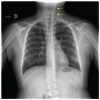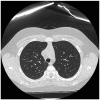Spontaneous pneumomediastinum and subcutaneous emphysema as a complication of asthma in children: case report and literature review
- PMID: 27585598
- PMCID: PMC5933618
- DOI: 10.1177/1753465816657478
Spontaneous pneumomediastinum and subcutaneous emphysema as a complication of asthma in children: case report and literature review
Abstract
Background: Spontaneous pneumomediastinum (SPM) is an uncommon disorder. It is rarely reported in paediatric patients and may be accompanied by subcutaneous emphysema. It is usually benign and self-limiting, with only supportive therapy being needed, but severe cases may require invasive measures. Asthma exacerbations have classically been described as a cause of SPM. However, detailed descriptions in asthmatic children are scarce. We aimed at improving the current understanding of the features of SPM and subcutaneous emphysema, and outcomes, by means of a case report and a systematic review.
Methods: For the systematic review a literature search was performed in PubMed to identify reported cases of SPM in asthmatic children.
Results: The case a 10-year-old asthmatic girl with SPM is reported. The patient received an inhaled corticosteroid and long-acting beta2 agonist, in addition to sublingual immunotherapy (SLIT) with eventual control of asthma symptoms.
Review: A total of 114 published cases were found since 1995, most of them in teenagers; no sex differences were observed. Clinical presentation was associated with an asthma exacerbation in a number of cases. Other presenting features were chest pain, dyspnoea, cough, and particularly acute swelling of the face, neck, and upper chest. Subcutaneous emphysema was present in most patients. Overall, three cases of pneumothorax and two cases of pneumorrhachis were reported. Therapy was mainly based on supportive care, rest, oxygen therapy, analgesics, steroids, and bronchodilators. All patients recovered spontaneously, in spite of a small initial increase in SPM in a few cases.
Conclusions: Early identification of patients at risk of SPM would avoid the high number of under-diagnosed cases. Patients should be treated not only with supportive therapy but also with measures to achieve control of the underlying cause (such as poorly controlled asthma).
Keywords: asthma; case report; children; spontaneous pneumomediastinum; subcutaneous emphysema; systematic review.
© The Author(s), 2016.
Conflict of interest statement
Figures
References
-
- Ba-Ssalamah A., Schima W., Umek W., Herold C. (1999) Spontaneous pneumomediastinum. Eur Radiol 9: 724–727. - PubMed
-
- Bousquet J., Heinzerling L., Bachert C., Papadopoulos N., Bousquet P., Burney P., et al. (2012) Practical guide to skin prick tests in allergy to aeroallergens. Allergy 67: 18–24. - PubMed
-
- Bullaro F., Bartoletti S. (2007) Spontaneous pneumomediastinum in children: a literature review. Pediatr Emerg Care 23: 28–30. - PubMed
Publication types
MeSH terms
Substances
LinkOut - more resources
Full Text Sources
Other Literature Sources
Medical



